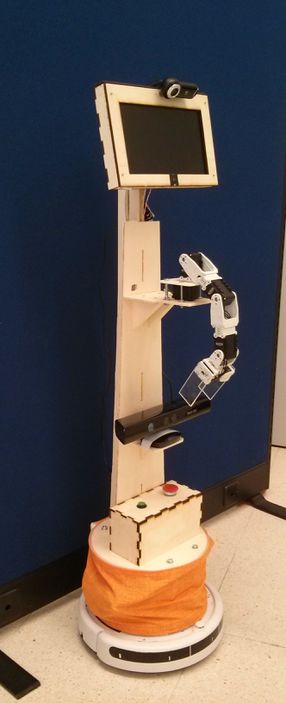Difference between revisions of "RoCKIn2014"
WikiSheriff (talk | contribs) (→Acknowledgments) |
WikiSheriff (talk | contribs) (→Acknowledgments) |
||
| Line 111: | Line 111: | ||
==Acknowledgments== | ==Acknowledgments== | ||
| − | 'Organizations:' | + | '''Organizations:''' |
[http://www.fablableon.org/ Fab-Lab León] | [http://www.fablableon.org/ Fab-Lab León] | ||
| Line 117: | Line 117: | ||
[http://catedratelefonica.unileon.es/ Cátedra Telefónica-Unileon] | [http://catedratelefonica.unileon.es/ Cátedra Telefónica-Unileon] | ||
| − | 'People:' | + | '''People:''' |
Alvaro Botas (MYRA software) | Alvaro Botas (MYRA software) | ||
| + | |||
| + | Joaquín Olmo (First MYRABot prototype Designer) | ||
Julián Orfo (Navigation Simulation) | Julián Orfo (Navigation Simulation) | ||
| − | |||
| − | |||
Revision as of 19:00, 12 January 2014
Contents
RoCKIn Camp 2014
- Project Name:
- Official Web Page
RoCKIn@home
- Project Codename
Watermelon
- Advisor:
Vicente Matellán Olivera
- Staff:
Technical software: Fernando Casado Technical software: Víctor Rodríguez Technical software: Francisco Lera Technical hardware: Carlos Rodríguez
- Other Information:
- Academic Year: 2013-2014
- SVN Repositories: soon...
- Tags: Augmented Reality, Elderly people, Remote-Assistance
- Technology: ROS, PCL, c++, svn, OpenCV, cmake, OpenGL, Qt, Aruco,
- State: Development
Project Summary
This challenge focuses on domestic service robots. The project aims to create robots with enhanced networking and cognitive abilities. They should be able to perform useful tasks such as helping the impaired and the elderly (one of the main goals of our group).
In the initial stages of the competition, individual robots will begin by overcoming basic individual tasks, such as navigating through the rooms of a house, manipulating objects or recognizing faces, and then coordinating to handle house-keeping tasks simultaneously, some of them under natural interaction with humans.
Robot
We want to take part in RoCKIn with the platform developed during the last two years in the Catedra Telefónica-ULE.
Robot Hardware
- iRobot Roomba 520
- Dinamixel Arm (5x12a)
- Wooden frame (yes, it is made of wood)
- Notebook (Atom processor) (the display has been taken apart from the main body)
- Kinect
- Arduino Mega
Robot Software
- ROS (robot control)
- MYRA (C/C++, ArUCo, Qt, openCV)
Proposal
We want to develop and deploy minimal functional abilities to be part of RoCKIn 2014.
- Navigation
- Mapping
- People recognition
- Person tracking
- Object recognition
- Object manipulation
- Speech recognition
- Gesture recognition
- Cognition
We are going to separate the development in three phases:
- Phase I: Initial Setup
- Phase II: Integration and architecture
- Phase III: Platform test
- Phase IV: Improvements and complex tasks
- Technical Challenge: Furniture-type Object perception
- Open Challenge: Exhibit and demonstrate the most important (scientific) achievements
Phase I: Initial Setup
Outline: Tasks developed in this phase
Phase II: Integration and Architecture
Outline: Tasks developed in this phase
Phase III: Platform test
Simulator
WARNING: This part is still in Spanish, please feel free to ask if you have any doubt.
Hardware
<wikiflv width="300" height="250" logo="true">/videos/Test1.flv</wikiflv>
<wikiflv width="300" height="250" logo="true">/videos/Test2.flv</wikiflv>
Non-Critical (but to-do)
- Android/iOS Teleoperation
- Desktop Qt interface (WIP)
Wishlist
- Roomba battery
- Arduino Mega (x2)
- Roomba base (520, 560)
Acknowledgments
Organizations:
People:
Alvaro Botas (MYRA software)
Joaquín Olmo (First MYRABot prototype Designer)
Julián Orfo (Navigation Simulation)


